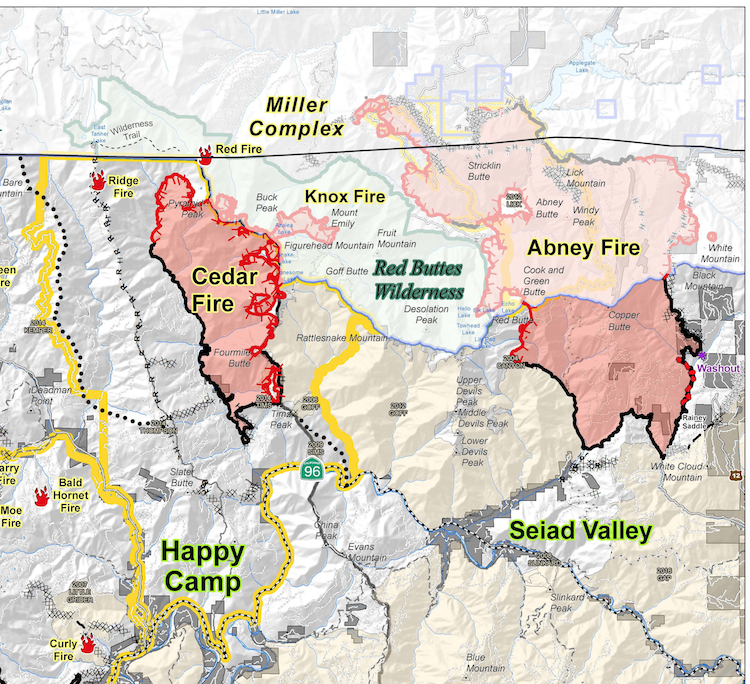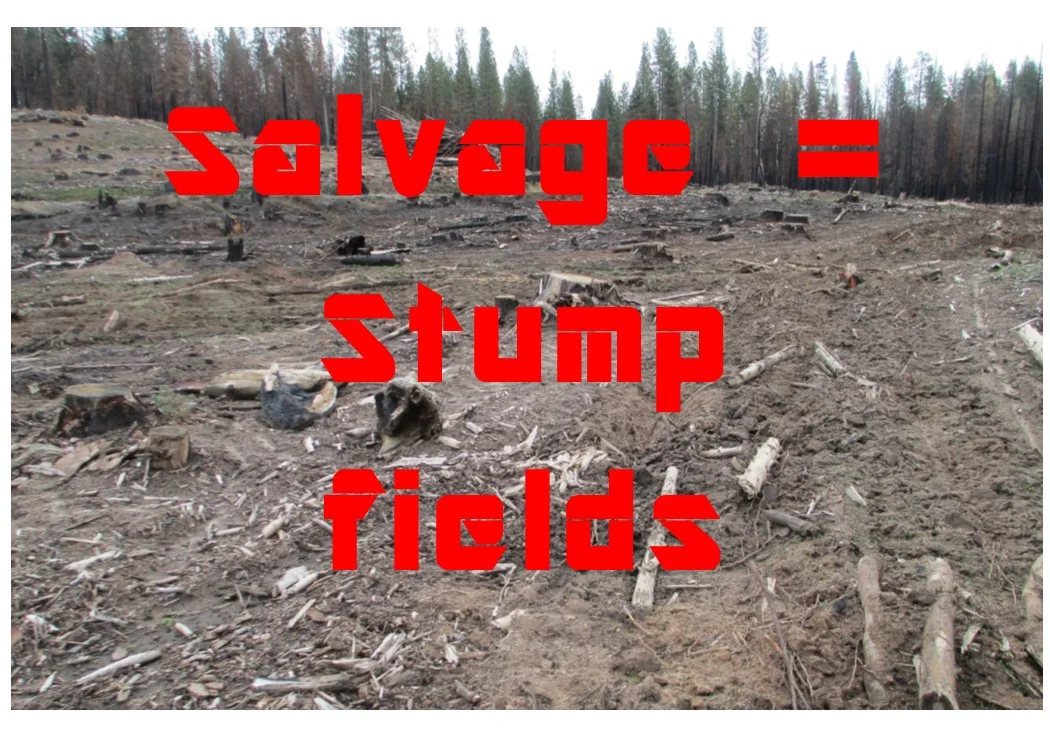Why Klamath National Forest's latest proposal for Post-Fire Logging is a bad idea:
Botanical Hotspot To Be Slicked off by Klamath National Forest
In the heart of the Siskiyous Mountains, Cook and Green Pass stands at the high divide between Seiad Valley to the south, and the upper Applegate Valley to the north. It is a primary gateway to the Red Buttes Wilderness, and is deserving of being part of the Wilderness. It is a designated Forest Service "Botanical Area" that is visited for botanizing, hiking, hunting and sightseeing. Treasured by many locals, it is also enjoyed by folks who have hiked thousands of miles on the Pacific Crest Trail.
A botanical hotspot of 700 acres located within the Siskiyou Crest Zone contains a mosaic of plant communities and is considered to be the dividing line between the eastern and western Siskiyous. This area has a phenomenal concentration of native plant species, one of the richest areas in California, with possibly as many as 300 species present. Botanists and plant enthusiasts from around the country have considered the Cook and Green Pass area significant for years.
This mature forest is proposed to be next on the chopping block for Klamath National Forest's timber agenda. The Abney fire burned in mixed severity fire within the Miller Complex fires. Cook and Green adjacent to the Red Buttes Wilderness burned hot as the fire rolled over the Pacific Crest Trail and into the Klamath National Forest on September 2nd, 2017.
The Klamath National Forest Has a “Salvage Logging” Addiction
The Klamath National Forest has a long history of rushing into timber sales once a fire touches their jurisdiction before it is even out. A brief history of bad salvage logging projects within the Klamath National Forest gives context to why the so-called “Seiad-Horse Risk Reduction Project” is really a timber grab by the Klamath National Forest.
“Many of us [Forest Service employees] had already spent long hours working through the Salmon Salvage Project (2014) and the Westside Fire Recovery Project (2016) and were reluctant to take on another large project, especially one that would require meeting an accelerated timeline. I also knew that putting forth a post-fire project would mean putting other green projects on hold, potentially risking having other areas burn in the future that could have been treated had we not reallocated resources for this project."- Forest Service Supervisor, Horse Creek Salvage, Final Record of Decision page 22.
As the Forest Service Supervisor in the Horse Creek Salvage, Record of Decision alluded to, the Klamath National Forest has a long history of rushing environmental analysis to push out large scale post-fire timber sales. The Klamath National Forest's “Response to Large-Scale Wildfires" since 2010, includes the following controversial post-fire logging projects
Abney Fire of the Miller Complex crosses into Klamath National Forest
Timeline of Post Fire Pillaging by the Klamath National Forest
2010: KNF Forest Supervisor signs decision document to salvage log the Panther Fire in the Happy Camp District. Rather than work on small-diameter fuels projects the KNF proposes salvage logging clearcutting in the backcountry on steep decomposed granitic slopes in the Elk Creek “key watershed” for salmon recovery. Project planners acknowledge the salvage logging will increase fire hazard:
“Upon completion of project activities [via Alternative 2], fire behavior would in the short term be greater than under Alternative 1 due to the small diameter material on site...[the] predicted rate of fire spread by year 20 is actually higher than under no action.”
-Panther Salvage Environmental Assessment, Klamath National Forest, at page 55.
2012: KNF Forest Supervisor initiates a planning effort to salvage log large-diameter snags deep within the Kangaroo Inventoried Roadless Area (IRA) associated with the Goff fire. Happy Camp Ranger District. The Kangaroo Roadless Area is one of the largest, most intact unprotected forested landscapes in California. After expending months of staff time pushing backcountry roadless area salvage clearcutting (instead of proceeding with planning small-diameter thinning projects near homes and communities) the KNF acknowledges that it is unlikely to succeed in post-fire clearcutting of the Kangaroo Roadless Area and scales back its logging proposal.
Westside "Salvage" Recovery Project, logs cut and sold for $.50 per thousand board foot
2014: The KNF Forest Supervisor signs a decision to conduct post-fire clearcutting in the Salmon River Salvage timber sale. Salmon River Ranger District. The controversial backcountry salvage logging project is litigated and the KNF settles the case by agreeing to drop numerous logging units located within Late-Successional Reserves (LSRs) within the Salmon River Key Watershed for salmon recovery. A great deal of Forest Service staff and legal resources were expended to log the remaining back-country salvage logging units, which included harmful wet-weather logging and haul activities.
2016: The KNF Forest Supervisor signs a decision to clearcut thousands of acres of post-fire forests located within the Late-Successional Reserve (LSR) land use allocation. Forest-wide. 12,000 comments are received in opposition to the proposed clearcutting. The Karuk Tribe presents a management proposal (Karuk Alternative) that is generally supported but that is rejected by the KNF in favor of controversial clearcutting and post-fire logging road construction in salmon-bearing watersheds. The US Fish and Wildlife Service issues KNF timber planners “take permits” for over 100 Northern spotted owls. Old-growth forests are sold to timber companies for $0.50 per thousand board feet, less than $2.00 a log truck.
2017: The KNF pushes ahead with another post-fire logging proposal, the Horse Creek Salvage logging project. Resources are again diverted from potential second-growth green tree thinning projects. After initially proposing and planning backcountry clearcut logging on the Siskiyou Crest, the KNF responds to project “objections” by working with interested stakeholders to reduce project impacts and increase protection for homes and communities.
Rare Botanical Area to be Heavily Logged Following the Abney Fire
Yet now the Klamath Forest Service is at it again, scoping notices for a salvage logging project called the “Seiad-Horse Risk Reduction Project” were published proposing over 10,000 acres of post fire pillaging within Late Succesional Reserves, Riparian Reserves, and Roadless Areas on the Siskiyou Crest near Cook and Green Pass, bordering the Red Butte Wilderness. Continuing to remake the mistakes of their past – the Klamath National Forest is proposing to replant the previously existing plantations that burned in stand replacing severity into yet again more tree plantations. However, the Klamath National Forest is also proposing over 40 miles of old growth logging off many unused roads in the backcountry. The service road 47N80 parallels the Pacific Crest Trail and would log trees alongside it as it knifes through one of the most iconic and botanically diverse wildlands in North America.



